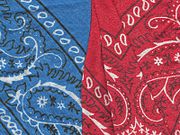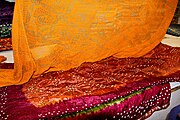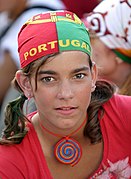Kerchief

Akerchief(from theOld Frenchcouvre-chef,"cover head" ), also known as abandanaorbandanna,is a triangular or square piece ofclothtied around thehead,face,orneckfor protective or decorative purposes. The popularity ofhead kerchiefsmay vary by culture or religion, often being used as aChristian headcoveringby men and women of theAnabaptist,Eastern Orthodox,andPlymouth Brethrendenominations,[1]as well as by someOrthodox JewishandMuslimmen and women and is also considered a hat.
Theneckerchiefandhandkerchiefare related items.
Types
[edit]Bandana
[edit]
Abandanaorbandanna(from Hindi and Urdu, ultimately from Sanskrit बन्धन orbandhana,"a bond" )[2]is a type of large, usually colourful kerchief, originating from theIndian subcontinent,often worn on the head or around the neck of a person. Bandanas are frequently printed in apaisleypattern and are most often used to hold hair back, either as a fashionable head accessory or for practical purposes. It is also used to tie around the neck to prevent sunburn, and around the mouth and nose to protect from dust inhalation or to hide the identity of its wearer.
The word bandana stems from the Hindi words 'bāndhnū,' or "tie-dyeing," and 'bāndhnā,' "to tie." These stem fromSanskritroots 'badhnāti,' "he ties," and Sanskrit 'bandhana' (बन्धन), "a bond."[3]In the 18th and 19th centuries bandanas were frequently known as bandannoes.[4]
Bandanas originated inIndiaas bright-coloured handkerchiefs of silk and cotton with spots in white on coloured grounds, chiefly red and blueBandhani.The silk styles were made of the finest-quality yarns and were popular. Bandana prints for clothing were first produced inGlasgowfrom cotton yarns, and are now made in many qualities. The term, at present, generally means a fabric in printed styles, whether silk, silk and cotton, or all cotton.[5]
The bandana found popularity in the US during the late 1700s becausesnuffusers preferred coloured and patterned silk handkerchiefs over white ones, as the former hid tobacco stains better when the users blew their noses. In the late 18th and early 19th centuries, bandanas began to appear with political and military advertisements printed on them.[citation needed]Such printed bandanas were common in the early and mid-1900s duringWorld War IandWorld War II.Decorative bandanas were also common gear, particularly asneckwear,forcowboys,and so forcountry and westernentertainers such asRoy Rogersand, later,Willie Nelson.[6]The latter singer began wearing bandanas when he moved fromNashvilleback toAustin, Texas,"just in time to catch the hippie wave cresting at counterculture center the Armadillo World Headquarters."[7]
Around the same time, bandanas also became popular with motorcyclists, particularly withHarley-Davidson ridersandbikers.[citation needed]In the 1970s paisley bandanas also became popular amongst gangs in California, most notably with two well-known rival gangs, theBloods,who wore red bandanas, and theCrips,who wore blue ones.[8]
Green bandanas have become a symbol of the abortion-rights movement.[9]
Oramal
[edit]
The Oramal is a traditional kerchief used inCentral Asiaand theCaucasus(note how it is tied, the neck is usually not covered by it). In some countries likeUzbekistan,it was traditionally used only at home, while in public theparanjawas more popular. In other countries, likeKazakhstan,it was commonly used in public. InKyrgyzstan,the white color is an indication that the woman is married.
As well it was widely used by men at horse riding in summertime instead of wearing a cap.
Austronesian headscarves
[edit]Kerchiefs are also worn asheaddressesbyAustronesian culturesinmaritime Southeast Asia.AmongMalaymen it is known astengkolokand is worn during traditional occasions, such as weddings (worn by the groom) and thepesilat.
See also
[edit]|
Other neckwear: |
Other headwear
|
References
[edit]- ^Hume, Lynne (24 October 2013).The Religious Life of Dress: Global Fashion and Faith.Bloomsbury Publishing.ISBN978-0-85785-363-9.
Following the general Anabaptist worldview, Hutterite dress not only emphasizes modesty but also separation from the world.... The women wear ankle-length skirts or dresses with a blouse, a kerchief-style head covering with polka dots (tiechle), usually black and white, and solid comfortable shoes.
- ^"Definition of bandanna".Merriam-webster. 2012-08-31.Retrieved2013-03-15.
- ^"Bandanna from Dictionary".Dictionary.reference.Retrieved2017-06-10.
- ^Yule and Burnell (2013), "Bandanna", p.78.
- ^Curtis, H. P. (1921).Glossary of Textile Terms.Marsden & Co. Ltd.
- ^Hilgers, Laura (November 2020)."The Global History of the Bandana".Smithsonian Magazine.Retrieved14 March2024.
- ^"Nine-Things-You-Didnt-Know-About-Willie-Nelson".6 June 2012.Retrieved2021-01-19.
- ^"Ethnic Dress in the United States: A Cultural Encyclopedia2016 010 Edited by Annette Lynch and Mitchell D.Strauss Ethnic Dress in the United States: A Cultural Encyclopedia Lanham, MD Rowman & Littlefield 2015 x + 326 pp. 9780759121485(print) 9780759121508(e-book) £49.95 $75".Reference Reviews.30(1): 17. 2016-01-18.doi:10.1108/rr-09-2015-0225.ISSN0950-4125.
- ^"How the green bandanna became a symbol of the abortion rights movement".The Seattle Times.2022-07-07.Retrieved2023-06-19.
- Additional sources
- Hilger, Laura (November 2020)."The Global History of the Bandana".Smithsonian Magazine.
- Yule, Henry, & A.C. Burnell (2013).Hobson-Jobson: The Definitive Glossary of British India.(Oxford, England: OUP).ISBN9780191645839.





